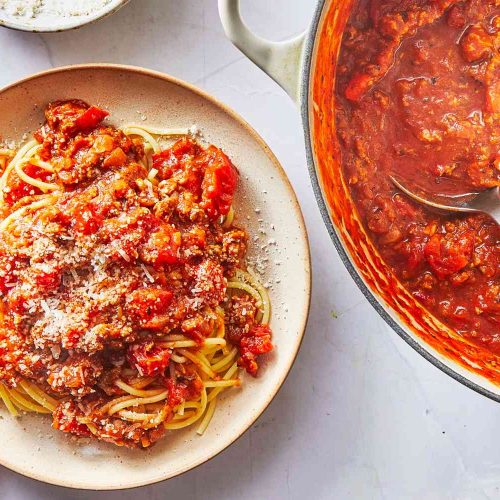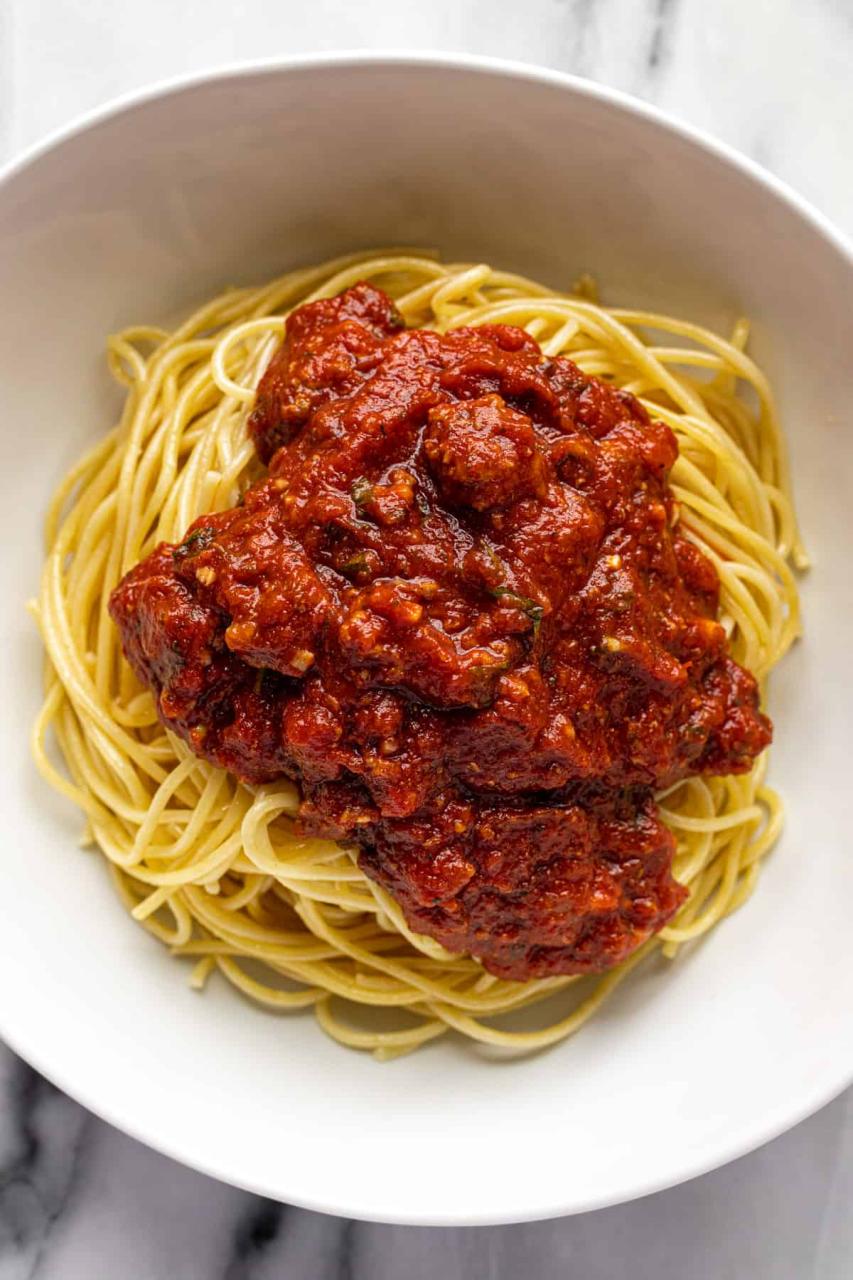Benvenuti to Italy Today Restaurant’s virtual kitchen! I’m Chef Luca, and it’s my absolute pleasure to guide you through the art of crafting the perfect spaghetti sauce, a staple in our beloved Italian cooking. Here, at italytodayrestaurant.com, we’re not just sharing recipes; we’re sharing a piece of our heritage.
Imagine walking through the bustling markets of Naples, handpicking sun-kissed tomatoes, fragrant basil, and robust garlic. That’s the feeling I want to bring to your kitchen. Each simmering pot of sauce is a story – one of rustic charm, family secrets, and the simple joys of Italian life.
Let me share with you a recipe that has been in my family for generations, adapted over the years to reach what I believe is the epitome of balance and flavor. With a swirl of the spoon, you’ll blend ripe tomatoes with a mélange of herbs, each element hand-selected for its contribution to the symphony of taste.
Through our website, you’ll not only get my trusted spaghetti sauce recipe, but also the tricks to turn good into great: the perfect olive oil drizzle, the precise moment to add the basil, and how to achieve that velvety smoothness that clings lovingly to each strand of pasta.
Join me, your amico in the kitchen, and let’s embark on a culinary adventure together. With a dash of love and a pinch of flair, you’ll be serving up a piece of Italy on every plate. Buon appetito!
Spaghetti sauce recipe


Spaghetti sauce
Equipment
- 1 large saucepan
- 1 saucepan
Ingredients
- 675 g 1 1/2 lb flesh of sweet or hot Italian sausage (ideally a
- mixture of both)
- 675 g 11/2 lb lean ground beef
- 60 ml 1/4 cup olive oil
- 1 to 2.5 ml 1/4 to 1/2 tsp. crushed hot pepper flakes
- 3 onions finely chopped
- 4 carrots peeled and diced
- 4 stalks celery diced
- 4 garlic cloves minced
- 1 can of 156 ml 5 1/2 oz tomato paste
- 2 cans of 796 ml 28 oz diced Italian tomatoes
- 2 cans of 796 ml 28 oz crushed tomatoes or tomato sauce
- 500 ml 2 cups beef broth
- 10 ml 2 tsp. Dried oregano
- 2-3 garlic cloves
- Salt and pepper
Instructions
- In a large saucepan, brown the meat in 30 ml (2 tbsp.) of oil, half at a time, with chili. Add oil as needed. Add salt and pepper. Set aside in a bowl.
- In a saucepan, soften the onions, carrots, celery and garlic in the remaining oil. Add salt and pepper. Add tomato paste and cook for 1 minute on high.
- Add meat, tomatoes, tomato sauce, broth, oregano and garlic cloves. Bring to a boil and simmer gently, stirring and scraping the base of the pan regularly, for about 3 hours or until sauce thickens. Serve over your preferred pasta.
Video
Each region in Italy has its own twist on spaghetti sauce

Naples (Neapolitan Sauce): In Naples, the sauce is often simple and fresh, highlighting the quality of the local San Marzano tomatoes. Ingredients:
- 1 can of San Marzano tomatoes
- 2 cloves of garlic, minced
- 1 small bunch of fresh basil leaves
- 2 tablespoons extra-virgin olive oil
- Salt to taste
Instructions:
- In a saucepan, heat the olive oil over medium heat, and add the minced garlic. Cook until it’s lightly golden.
- Crush the San Marzano tomatoes with your hands or a fork, and add them to the pan with their juices.
- Season with salt and bring to a simmer.
- Add a few fresh basil leaves and let the sauce cook for about 20-30 minutes, stirring occasionally.
- Serve over your favorite pasta, garnished with more fresh basil.
Bologna (Bolognese Sauce): Typical of the Emilia-Romagna region, with Bologna as its center, this meaty sauce is quite different from the Neapolitan variety. Ingredients:
- 400 grams of ground beef
- 150 grams of pancetta or bacon, finely chopped
- 1 onion, finely chopped
- 1 carrot, finely chopped
- 1 celery stalk, finely chopped
- 1 cup red wine
- 800 grams of canned tomatoes, crushed
- 1 cup whole milk
- Olive oil
- Salt and black pepper to taste
Instructions:
- In a large pan, heat olive oil over medium heat and add the pancetta or bacon, frying until it starts to crisp.
- Add the onions, carrots, and celery, cooking until they soften.
- Increase the heat, add the ground beef, and cook until browned. Season with salt and pepper.
- Pour in the red wine and reduce the heat once it has mostly evaporated.
- Add the crushed tomatoes and bring to a simmer. Then, partially cover the pan and let it cook on low heat for at least 2 hours, stirring occasionally.
- During the last 30 minutes of cooking, add the milk and adjust the seasoning as needed.
- Serve with tagliatelle or another wide, flat pasta to hold the sauce.
Each of these sauces reflects the local flavor preferences and culinary practices, offering a taste of Italy’s rich regional diversity. Experiment with ingredients from your area to give these recipes a local twist of your own.
Tips for making about Spaghetti sauce

Cooking Tips
- Use the Best Ingredients: The foundation of any great sauce is the quality of its ingredients. Hunt for the ripest tomatoes, the freshest herbs, and high-quality extra-virgin olive oil. San Marzano tomatoes are particularly prized for their sweet flavor and low acidity.
- Sauté Aromatics Gently: Begin by gently cooking your onions, garlic, or shallots in olive oil just until they’re soft and fragrant. This will create a flavor base that permeates the entire sauce without overpowering it.
- Crush Tomatoes by Hand: For a more rustic texture, consider crushing your tomatoes by hand instead of blitzing them to a puree. This method offers pockets of tomatoey goodness throughout your sauce.
- Simmer Slowly: Patience is key with spaghetti sauce. A slow simmer allows the flavors to meld together beautifully. The longer it cooks, the more complex and deep the flavor will become – but keep an eye on it to prevent burning.
- Season Properly and Thoughtfully: Salt is crucial in bringing out the best in your tomatoes and herbs. Add it gradually and taste often. A pinch of sugar can be a secret weapon against acidity.
- Enhance with Wine: A splash of good red wine can add depth and richness to your sauce. Let it cook down to concentrate the flavor before adding in your tomatoes.
- Finish with Fresh Herbs: While dried herbs work well during the cooking process, finishing your sauce with freshly chopped basil, oregano, or parsley can add a bright, fresh flavor that makes the sauce come alive.
Serving suggestions

- Classic Pasta Dish: Toss freshly cooked spaghetti in the sauce, ensuring each strand is coated evenly. Garnish with grated Parmesan cheese and fresh basil leaves for an authentic Italian touch.
- Meat Accompaniment: If you have prepared a Bolognese or another meat-based variation, serve it over wide pasta like pappardelle or tagliatelle, which holds up well against hearty sauces.
- Vegetarian Option: For a vegetarian twist, incorporate roasted vegetables such as eggplant, zucchini, and bell peppers into your tomato-based spaghetti sauce and serve over your choice of pasta.
- Dipping Sauce: Use the marinara or a slightly thicker spaghetti sauce as a dip for mozzarella sticks, garlic bread, or a medley of fried appetizers. You can warm the sauce and sprinkle some chili flakes for an extra kick.
- Layered in Lasagna: Spaghetti sauce can also become the tomato layer in lasagna. Alternate with sheets of pasta, béchamel sauce, and cheese for a delicious baked entrée.
- Stuffed Bell Peppers or Eggplants: Fill hollowed-out bell peppers or eggplants with a mixture of rice, ground meat, and spaghetti sauce, then bake until tender.
- Pizza Base: Spread a thin layer of the sauce over your pizza dough before adding your favorite toppings and cheese for a homemade pizza night.
- Meal Prep: Spaghetti sauce can be used for meal prep as it stores well and can be used throughout the week in different dishes, from pasta to grain bowls.
- Baked Eggs: For a breakfast twist, spoon the sauce into a baking dish, make wells, crack eggs into the wells, and bake until the eggs are set.
- Soup Starter: A hearty tomato sauce can serve as a base for minestrone or a simple tomato soup if thinned out with stock or water and additional seasonings.
Top 5 FAQs about Spaghetti sauce

- What are the essential ingredients in a traditional spaghetti sauce? Traditional spaghetti sauce typically consists of ripe tomatoes, which provide a balance of sweetness and acidity. Extra-virgin olive oil is used for sautéing aromatics like garlic and onions, which lay the flavor foundation. Herbs such as basil or oregano add that classic Italian seasoning, while salt and pepper are used for overall seasoning.
- How can I make my spaghetti sauce taste better? To enhance the flavor of your spaghetti sauce, start by using high-quality, fresh ingredients. Sauté your aromatics gently to release their full flavor without burning them, and cook your sauce slowly to allow the flavors to meld together. Consider crushing the tomatoes by hand for a rustic texture, and don’t be afraid to season appropriately with salt and special touches like a pinch of sugar or a splash of wine. Adding fresh herbs towards the end and allowing your sauce to rest before serving can really elevate its taste.
- Can spaghetti sauce be made vegetarian or vegan? Yes, spaghetti sauce can easily be adapted for a vegetarian or vegan diet. The basic tomato-based sauce is already vegetarian, and you can enrich it with vegetables like roasted eggplant, zucchini, or bell peppers. For a vegan variant, simply ensure no meat products or cheeses are used unless they are plant-based substitutes.
- How long should I cook my spaghetti sauce? Cooking time can vary depending on the recipe and personal preference. A simple tomato sauce may only need about 20-30 minutes to simmer and develop flavors, while a meat sauce like Bolognese could benefit from at least 2 hours of slow cooking to achieve richness and depth.
- Can I freeze leftover spaghetti sauce? Spaghetti sauce generally freezes very well. Allow the sauce to cool completely before transferring it to airtight containers or heavy-duty freezer bags. Properly stored, it can last in the freezer for about 4-6 months. When ready to use, thaw it in the refrigerator overnight and reheat gently, adjusting seasonings if necessary.
In conclusion, spaghetti sauce is much more than a mere accompaniment to pasta; it’s a vibrant expression of culinary culture and tradition. Its rich tomato base, enlivened by aromatic herbs and garlic, serves as the canvas on which countless variations can be painted. From the meat-laden Bolognese to the simple and fresh marinara, each type of sauce reflects the creativity and tastes of its maker.
Whether you prefer a slow-cooked sauce that has simmered for hours to achieve complex depths of flavor or a lighter, quicker version that celebrates the tomato’s natural zest, there’s a spaghetti sauce to suit every palate and occasion. Its versatility allows for adaptations to any dietary need, making it universally embraced in kitchens around the globe.
